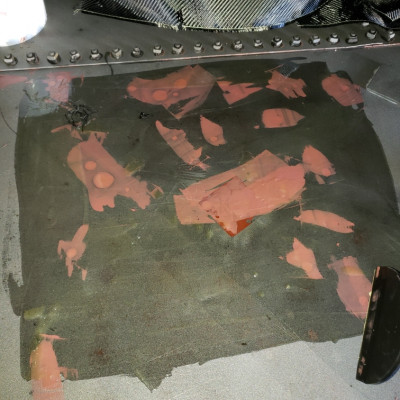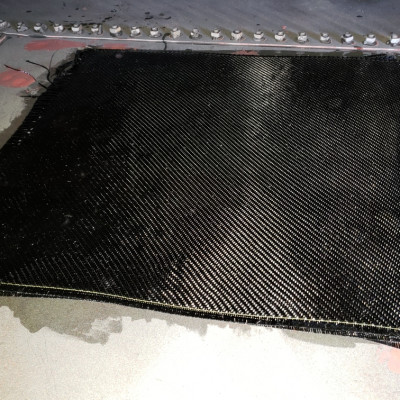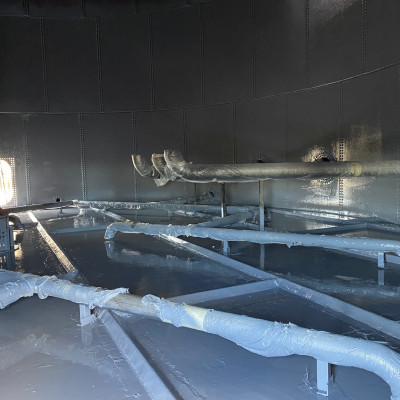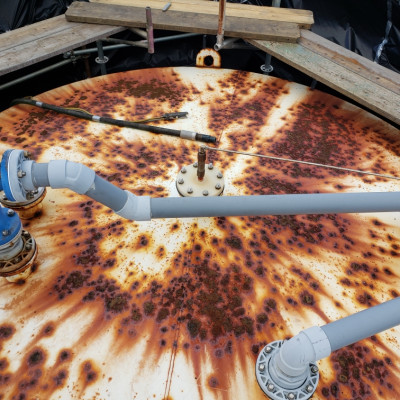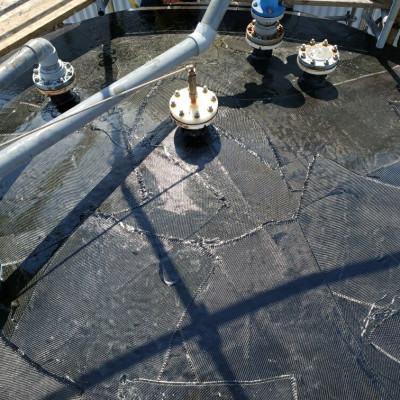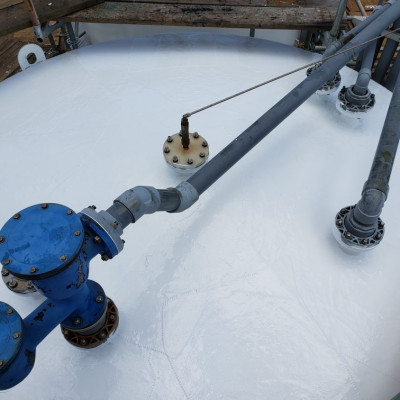Industrial Tanks and Corrosion
Corrosion is one of the major issues faced by industrial tanks. It shortens a tank’s lifespan incrementally and increases the possibility of environmental contamination.
As tanks age, they are prone to both external and internal corrosion. External corrosion will occur from environmental exposure to sun, wind, water, and variable temperatures. Aging or damaged exterior coatings will significantly increase the rate of external corrosion.
Internal corrosion is also common for tanks containing water. Even trace amounts of moisture in Oil tanks will cause internal corrosion if the tank is not properly protected. Chemicals like hydrogen sulfide can also significantly increase the rate of corrosion.
Thick film coatings and fiber-reinforced composite systems have been used for tank bottom repair and reinforcement for years. Current technologies, like carbon fiber-based composites, have increased the range of available repairs to include full composite tank reinforcement, sectional reinforcement, and repairs of cracks and pinholes using a composite patch.
What is a Composite Patch?
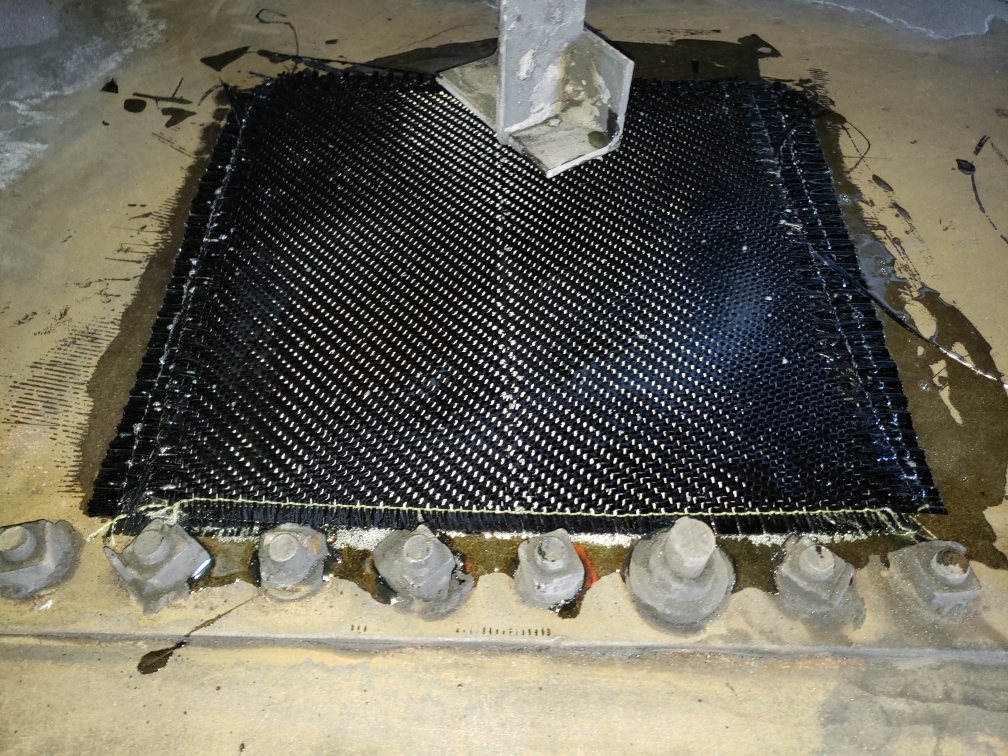
A composite patch repair is widely used in the repair of metal and composite parts including pipes, tanks, beams, plates, and pressurized vessels.
A composite patch consists of reinforcing fabric and a resin binder. Composite repairs are performed on damaged steel pipes and tanks, composite laminate structures, fiber-reinforced composites, concrete, and other metallic substrates. The patch is placed over the damaged area after proper surface preparation to ensure adequate adhesion. The patch will prevent leakage, stop further corrosion and provide local strengthening to the patch area.
Small cracks and pinholes within the tank can successfully be repaired using a composite patch repair. To ensure crack growth or propagation does not continue under the composite patch, a crack should always be removed or properly terminated.
A repair patch made of carbon fiber and an immersion grade epoxy is not just a temporary repair; due to its high adhesion strength, outstanding tensile strength, and resistance to many aggressive chemicals, a composite repair patch can provide 20 years of structural health to the repaired tank.
Composite repairs versus traditional methods
Traditional weld repairs require abrading of the existing surface followed by welding on a steel plate where the heat affects both internal and external coating within the vicinity of the weld repair. The use of a composite patch is not a hot process so there is no detrimental effect on the tank or the existing coating.
Carbon fiber composites are lightweight, high temperature resistant, and of high strength with 10 times the strength-to-weight ratio of carbon steel. For larger repairs, the added weight of the welded plate is a significant hindrance. Further, carbon fiber-based composites are not prone to oxidation like metallic repairs and do not require subsequent grit blasting and coating.
The area of a repair also has a large effect on the ability to perform a weld repair. The plate has to match the dimension and contour of the repair area. Because carbon fiber composites are pliable when applied, they can be installed to perfectly match the configuration of even a complex repair area.
The epoxy-based polymers in carbon fiber patch repairs bonds to a wide range of substrates, including carbon and stainless steel, aluminum alloy, concrete, fiberglass, and even wood.
Designed to withstand high temperatures, certain composite repairs are suitable for temperatures up to 375°F as well as assets that experience thermal cycling. Composite patch repairs can withstand both hoop stress and vacuum pressure.
Why Use a Composite Patch for Tank?
There are several advantages of composite patch repairs as a repair material.
- Installation of composite repairs is a cold process with no effect on the tank coatings.
- A composite patch is flexible and perfectly fits any shape of the tank and any area within the tank.
- A composite patch is extremely compatible with corrosion prevention coating systems because it is epoxy-based. You can simply apply coating right on top of your patch as opposed to doing grit blasting as an additional step after a weld was installed.
- The mechanical performance like fatigue resistance and ultimate tensile strength is significantly higher than Carbon steel
- Excellent fatigue life for repairs with vibrations, thermal cycles, or other variable loadings.
Outstanding chemical resistance - Provides 20-year service life to the repaired structure without any required maintenance.
- Finite element analysis (FEA) can be used to determine the optimal thickness of a repair.
Types of Tank Repair With a Composite Patch
There are several types of repair that can be done using a composite patch.
Spot repairs
For tanks experiencing isolated corrosion or erosion, even with through-wall failures, a carbon fiber composite patch may be the best solution. The repair patch can be installed quickly and efficiently on a damaged area and provides a high-strength, chemical-resistant barrier compatible with a wide range of high-performance coatings. Pinhole leaks and repairs of failing or degraded weld seams are often fixed with a repair patch.
Installation process
- Following grit blasting, epoxy putty is applied to any irregularities like pitting and weld seams on the repair area.
- A high-strength adhesive is then applied to the entire repair area.
- A high-strength, bi-directional carbon fiber fabric is saturated with an epoxy saturating resin and installed over the damaged area.
- After the composite is allowed to cure overnight and an Epoxy topcoat is applied over the entire repair area.
Tank bottom repair
For tanks that do not have uniform degradation across the entire tank surface, we offer spot repairs for areas that are below the minimum wall thickness threshold or for through-wall failures. Hydrocarbon storage tanks generally have their corrosion isolates at the bottom.
This type of repair doesn’t require scaffolding; it is very cost-effective, quick to install, and provides a long-term life extension for these tanks.
Installation process
- The tank is cleaned then grit-blasted to an SSPC SP-10 Near White Metal Finish.
- A hold primer is applied to prevent the floor from flash rusting. The primer serves as a barrier to separate the composite from steel and to increase adhesion level
- After the primer, the composite system is installed through a hand laid-up process: the carbon fiber fabric is saturated with an epoxy saturating resin and laid in place, one layer at a time. It usually takes multiple layers of composite to finish the repair.
- After the composite is fully installed, a corrosion-resistant topcoat is applied to the entire repair system and the edges of the repair to ensure that the carbon fiber composite itself is not exposed to the chemicals in the tank.
Tank Roof Repair
Tank roof repairs are generally less structural and more preventative in nature. They are applied to prevent leaks and through wall failures and stop any exterior corrosion from occurring. If the leak is registered on the roof, a composite patch is an excellent solution not only to seal the initial crack but to provide added structural support.
Tank roof repairs can be done either internally or externally. Both ways require the surface to be grit blasted.
Installation process
- After surface preparation and grit blasting an adhesive resin is applied to the repair area to prevent flash rust and help hold the composite in place.
- Several layers of composite carbon fiber saturated with an epoxy saturating resin are then installed.
- A UV or Immersion grade topcoat is then installed and the repair is allowed to cure for 24 to 48 hours.
Tank Shell Repair
Tank shells can be repaired with a composite patch either internally or externally. Whenever possible, an internal repair is a better solution as it gives more longevity to your repaired structure by preventing internal corrosion.
Further, when performing an external repair with a composite patch, the fluid is pressing the composite patch out, whereas with an internal repair the fluid is pressing the composite patch against the substrate, which provides maximum efficiency and more lifetime to the repair.
Installation process
- After grit blasting, through-wall failures in the shell are temporarily plugged and all weld seams and pitted areas are smoothed over with high-build epoxy putty.
- An adhesive layer is applied over the entire repair area then high-strength, aerospace-grade carbon fiber fabrics are saturated with a specially formulated saturating resin and applied over the repair area by hand lay-up.
- A minimum of three layers of saturated carbon fiber fabric are applied, followed by an epoxy coating system that is rolled onto the composite to provide a topcoat and complete the composite repair system.
Composite Repair with Patches – Industry Application
Aerospace, Marine, and Automotive Industry
Composite materials are used in a wide range of applications in aerospace (cracked metallic aircraft structures), marine, automotive, surface transport, and sports equipment markets, where the ability to withstand aggressive environmental conditions is crucial.
The basic principle of composite repair is to adhesively bond a composite patch over the cracked area in order to restore the load-carrying capacity of the structure
Oil & Gas and Chemical Industry
Composite patches are widely used for tank reinforcement in the oil and gas industry. Oil tanks or hydrocarbon-containing tanks often have corrosion on the bottom due to water separating out and sitting at the bottom. Chemical plants have similar issues, although less prevalent as their products typically have higher purity and lower moisture content than crude oil.
Water & Wastewater Industry
Any industry that uses water tanks, whether it’s processed water, potable water, demineralized water, or wastewater can also be affected by tank corrosion, especially if the tanks are not properly coded or if the coatings have exceeded their service life.
Need a Tank Crack Repair?
At Advanced FRP Systems, we value the trust our customers put in us to take the time to dive into their unique problems, and build the right custom solution. We can help with the installation of basic patches, as well as more complex repairs.
If you are in need of a composite repair including crack repairs, corrosion repairs, erosion repairs, or if you would like to consult with one of our tank repair experts to find a repair solution that fits your needs, call us at 508-927-6915, or email us at [email protected].

